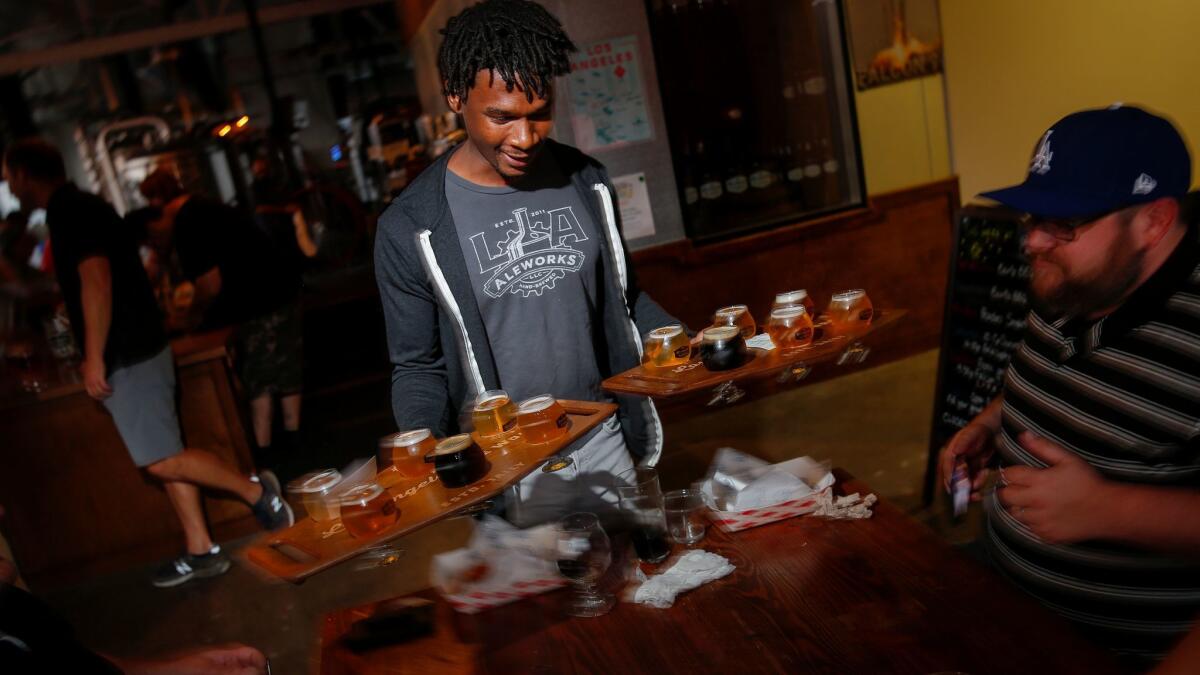California minimum-wage workers get a 50-cent raise starting next week as pay heads toward $15

- Share via
Many lower-paid workers in California will get a raise on Jan. 1 under the state’s new minimum-wage law, which will eventually boost hourly pay to at least $15.
Starting Monday, small companies — those with 25 or fewer employees — will have to pay workers at least $10.50 an hour, up from $10. For those companies, it marks the first of several pay increases mandated by the minimum wage law approved in 2016. Minimum-wage workers at larger companies, who saw their pay increase to $10.50 last January, will get bumped up to $11 an hour on Monday.
Wages will continue to rise incrementally over the next several years. By 2022, employees at large companies will get $15 per hour, a figure that has been the rallying cry of a national movement to boost pay for low-wage workers. Employees at smaller firms will reach $15 an hour in 2023. The increases can be delayed if the state’s economy falters.
Many minimum-wage workers in Southern California, including those in the city of Los Angeles, are already being paid more because of local wage ordinances.
In Los Angeles, Pasadena and Santa Monica, the minimum hourly wage is already $12 for large companies and $10.50 for small firms. Those rates will climb to $13.25 and $12, respectively, in July, and reach $15 in 2020 for large companies and 2021 for small ones. Rules in Los Angeles, Long Beach and Santa Monica also require even higher minimum pay for some hotel workers.
Some Bay Area cities are set to hike wages even further. In Palo Alto, the minimum wage will rise to $13.50 on Jan. 1, up from the current $12. In Mountain View, the minimum wage will climb to $15 from $13, also on Jan. 1.
Proponents of the wage hike pitched the issue as one of economic justice, saying it would help shrink the growing divide between rich and poor and help working families struggling with California’s high housing costs. Business groups and other opponents, meanwhile, predicted a $15 minimum would kill off some small businesses, force others to raise prices and ultimately result in fewer job opportunities as employers cut back on hiring, especially in the Central Valley, Inland Empire and other regions where both wages and living costs are generally lower than in the state’s major coastal cities.
Dueling studies in California and Washington have sought to assess those claims, but came to wildly different conclusions.
A study from the UC Berkeley researchers suggested the wage hike would lead to more consumer spending and, as a result, to more jobs. One from the University of Washington, though, suggested that employers in Seattle, following a wage hike in that city, created fewer new low-wage jobs than expected based on activity in surrounding cities.
The coming raise will mean an extra $1,040 in income over a year for a full-time worker earning the minimum wage. Giannina Campos, 26, a bartender at Los Angeles Ale Works, a Hawthorne brewery, said any pay increase is nice, but that an extra 50 cents an hour won’t have a major impact on her budget or help her move out of her parents’ home.
“I don’t think people can live off that with one job, at least if they’re renting,” said Campos, who is working to pay off student loans while she looks for a full-time job as a teacher. “But at least it’s something.”
For businesses, the coming pay increase will mean thousands of dollars in additional payroll costs. Some say they’ll raise prices accordingly, while others say they’re looking to trim non-labor costs to make up the difference.
At L.A. Ale Works, co-founder Andrew Fowler said he expects his payroll to rise between $5,000 and $6,000 in 2018 because of the wage increase. The brewery has 12 employees, half of whom make the minimum wage, plus tips. Those workers will go from $10 an hour now to $10.50 on Monday.
To make up for the added expense, Fowler said he’s looking for small savings here and there. For instance, he said he found a new supplier for coasters that will charge 6 cents per coaster instead of 11 cents.Those 5 cents, multiplied by tens of thousands of coasters, adds up to a few thousand dollars in savings, he said.
“Coasters are relatively expensive, but people look at them, they tear the corners off, they make shapes, dip them in their beer — it blows my mind,” he said. “People need livable wages, and I think [the minimum wage] is headed in the right direction, so it’s just going to be a matter of us figuring out how to reduce costs without reducing labor.”
Finding cost savings to make up for a 50-cent pay bump is one thing, but Fowler said the brewery will have to grow its sales significantly to cover the additional minimum-wage increases coming over the next several years.
In nearby Torrance, Laurie Porter, co-owner of Smog City Brewing Co., said the 50-cent raise won’t have a big impact, but that future raises will. Smog City has 26 employees, just enough that it’s already paying $10.50 to half a dozen minimum-wage employees and will start paying $11 on Monday.
“Once it gets to about $14 an hour, I think we’ll have to change our pricing on our beers,” she said. The state minimum will reach that level for large employers in 2021.
Already the brewery, which also operates a tap room in Long Beach, decided to charge sales tax on top of the listed price of its beers. Like many of its peers, Smog City had previously listed a tax-inclusive price for pints.
Porter said that change was mostly a way to pay for additional benefits to workers but that it also helped take the edge off last year’s wage increase.
She and others in the restaurant and hospitality industry say they’d like to see the state amend its minimum-wage law so that tipped workers such as bartenders could be paid a lower hourly rate. Restaurateurs have long complained that without such a change, so-called front-of-house workers often end up with significantly higher pay than cooks and other back-of-house staff.
Joe Picarelli, owner of Picarelli’s restaurant in Long Beach, said servers make more than twice the minimum wage when tips are included, and that raising their hourly pay makes it more difficult to offer raises to others.
“I can understand the laborer, the back-of-the-house guys. I can understand giving the kitchen a little bit of a raise,” he said. “But the wait staff? They work for the tips.”
Follow me: @jrkoren
More to Read
Inside the business of entertainment
The Wide Shot brings you news, analysis and insights on everything from streaming wars to production — and what it all means for the future.
You may occasionally receive promotional content from the Los Angeles Times.







